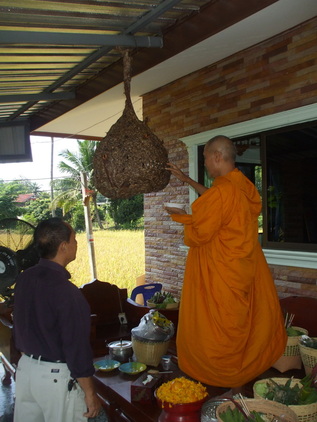|
A large wasps’ nest as a talisman is more common in rural areas where wasps’ nests are more common. Around our part of Northern Thailand many houses will display wasp nests or hornets’ nests above or near the front door. In the picture accompanying this essay, a priest is anointing a particularly large (abandoned!) nest on the occasion of a house blessing. The priest is marking the nest with bun (lime) paste, made of the same powdered mountain lime that is chewed with betel nuts. This lime paste is traditional for symbolic anointing on auspicious occasions. Lintels, name plates, foundation stones and royal plaques are often anointed with a pattern of dots or with an auspicious number, usually the number 9. This act of decoration may be accompanied by a chanted benediction, or the blessing might simply be implied.
We will now consider two questions about what is happening and why. First, to what category of faith practice should this wasp-nest blessing be assigned? I think the most probable category is that this is a type of magical summoning of prosperity. It is indirect in that the thing symbolized and called for is not prosperity directly. More about that in a moment. It is magical because it presumes that an inanimate, inert object can and possibly will produce an unrelated result. It is analogous to kissing a magical stone to produce good luck or knocking on wood to prevent bad luck. The produce hoped from the wasp’s nest is prosperity, a vague but very positive accumulation of benefits. In Thailand talismans to summon prosperity are numerous. The most famous is the maiden Nang Kwak who sits on countless shelves dressed in a traditional Thai costume and crown, beckoning with her right hand palm down as one might summon a taxi or a friend. Nang Kwak is either inviting customers and thence prosperity, or she is calling for love, or both. This image or its ancestors goes back at least 2000 years. Nang Kwak images used to take great care with very special materials and inscriptions, but now they are mass produced. Less occult, and more akin to the wasp’s nest we are talking about, is the bamboo fish trap. It is also a form of sympathetic magic that works, presumably, by analogy. “As the fish trap lures fish in but does not let them out again,” the symbol alludes, “so are customers drawn by the flow of traffic into our shop where they contribute to our prosperity.” Plaited fish traps are actually used to catch fish, but when they are hanging full-size inside a shop near the cash drawer or in miniature form from the rear-view mirror of a car, their objective is merely equivalent to fishes. Second, why a wasp-nest? In the case of the wasps’ nest, it is not the action of the wasps either in protecting their colony through their famous attack strategy or their building of the complex habitat that is being remembered, but the fact that they are a dense community. They congregate and cooperate in their undertaking. Their life is harmonious and they multiply and add to their number. The prosperity they manifest is social. So their nest hung by a doorway is a suggestive signal, encouraging the powers that be to do likewise for the human household. The wasp-nest is intended to exert an unexplained energy to draw people into the enterprise of creating a prosperous social unit. Wasp-nest and fish-trap magic may seem a bit bizarre and far-fetched. It is hard to come up with an example of sympathetic magic that does not seem absurd to a modern scientific mind. The entire category is excluded from the realm of possibility when it is carefully scrutinized. However, there are religious medals and plaques in every culture and every religion. Their purpose is not very different. They identify those who display or wear them, but they also symbolize the aspiration for benefits, not least of which are prosperity and protection. They might not be thought of as magical, but they certainly are held to be evocative. They evoke the blessing being referred to no matter how that blessing is supposed to be produced. All over Thailand cars of Christian owners exhibit an “icthus” (fish) symbol, supposedly a testimony of faith but also (like the wasp’s nest) a call for community. A few generations ago almost every household in America contained the sentiment, “Home Sweet Home”. That’s the wasp-nest idea in the form of a cross-stitch sampler.
0 Comments
Leave a Reply. |
AuthorRev. Dr. Kenneth Dobson posts his weekly reflections on this blog. Archives
March 2024
Categories |
| Ken Dobson's Queer Ruminations from Thailand |
|

 RSS Feed
RSS Feed
